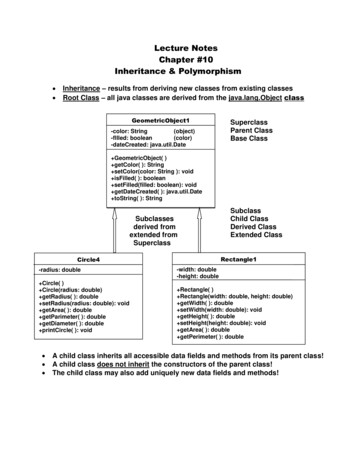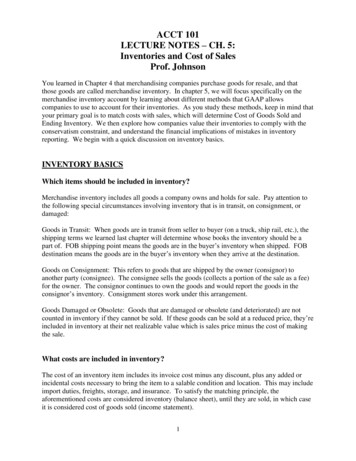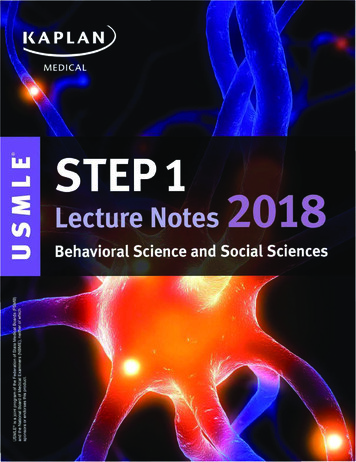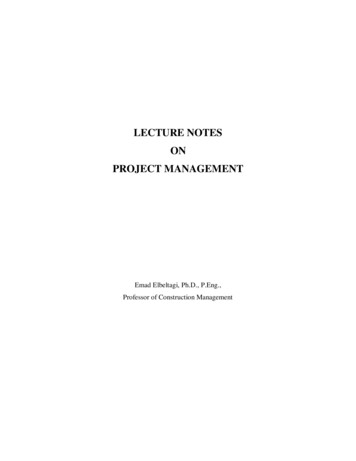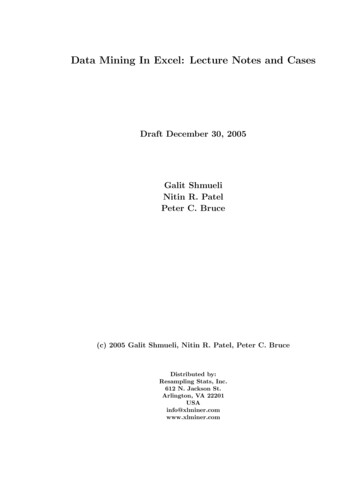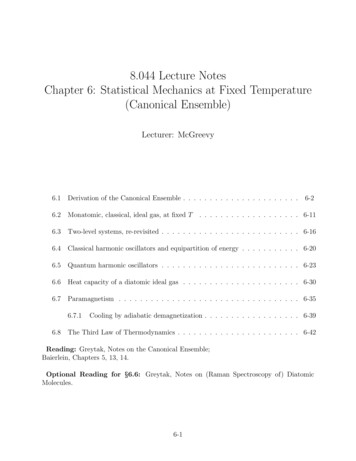
Transcription
8.044 Lecture NotesChapter 6: Statistical Mechanics at Fixed Temperature(Canonical Ensemble)Lecturer: McGreevy6.1Derivation of the Canonical Ensemble . . . . . . . . . . . . . . . . . . . . . .6.2Monatomic, classical, ideal gas, at fixed T6.3Two-level systems, re-revisited . . . . . . . . . . . . . . . . . . . . . . . . . . 6-166.4Classical harmonic oscillators and equipartition of energy . . . . . . . . . . . 6-206.5Quantum harmonic oscillators . . . . . . . . . . . . . . . . . . . . . . . . . . 6-236.6Heat capacity of a diatomic ideal gas . . . . . . . . . . . . . . . . . . . . . . 6-306.7Paramagnetism . . . . . . . . . . . . . . . . . . . . . . . . . . . . . . . . . . 6-356.7.16.86-2. . . . . . . . . . . . . . . . . . . 6-11Cooling by adiabatic demagnetization . . . . . . . . . . . . . . . . . . 6-39The Third Law of Thermodynamics . . . . . . . . . . . . . . . . . . . . . . . 6-42Reading: Greytak, Notes on the Canonical Ensemble;Baierlein, Chapters 5, 13, 14.Optional Reading for §6.6: Greytak, Notes on (Raman Spectroscopy of) DiatomicMolecules.6-1
6.1Derivation of the Canonical EnsembleIn Chapter 4, we studied the statistical mechanics of an isolated system. This meant fixedE, V, N .From some fundamental principles (really, postulates), we developed an algorithm for calculating (which turns out not to be so practical, as you’ll have seen e.g. if you thought aboutthe random 2-state systems on pset 6):1. Model the system2. Count microstates for given E: Ω(E, V, N ).3. from Ω, derive thermodynamics by S kB ln Ω.4. from Ω, derive microscopic information by p(X) Ω0 (X).ΩThe fixed-energy constraint makes the counting difficult, in all but the simplest problems(the ones we’ve done). Fixing the temperature happens to be easier to analyze in practice.Consider a system 1 which is not isolated, but ratheris in thermal contact with a heat bath 2 , and thereforeheld at fixed temperature T equal to that of the bath.An ensemble of such systems is called the “canonical ensemble”. I don’t know why.The fact that T is fixed means E is not: energy can beexchanged between the system in question and the reservoir.heat bath, TAssume that 1 2 together are isolated, with fixed energy Etotal E1 E2 . Then wecan apply the microcanonical ensemble to 1 2 . Note that 1 could be itself macroscopic(it just has to have a much smaller CV than 2 ), in which case we can learn about itsthermodynamics. Alternatively, 1 could be microscopic, with just a few degrees of freedom(like one square of a grid of 2-state systems, in which case we can ask for the probabilitythat it is ON).6-2
Consider a specific microstate A of 1 with energy E1 .Q: What the equilibrium probability that system 1 is in state A? We can apply the methodof Chapter 4 to 1 2 :Ω01 2 (A)) Ω1 2 (Etotal ){p1 , q1 } {z }Prob(system 1 is in state A) p(specific values for all vars of system 1 in state A # of microstates of system 2 with energy Etotal E1total # of microstates of 1 2 with energy Etotal E1 E2 , fixedp({p1 , q1 }) Ω2 (Etotal E1 )Ω1 2 (Etotal )Take logs for smoother variation:kB ln p({p1 , q1 }) S2 (Etotal E1 ) S1 2 (Etotal ) {z }E2So far, what we’ve done would be valid even if systems 1 and 2 were of the same size.But now let’s use the fact that 2 is a reservoir by recognizing that E1 Etotal . We shouldTaylor expand in small E1 : 2 kB ln p({p1 , q1 }) ' S2 (Etotal ) E1 E2 S2 (E2 ) E2 Etotal O(E1 ) S1 2 (Etotal ) {z}1T2 S211 E2T2Twhere T is the temperature of the bath 2 . (Here we are using the fact that 2 is a reservoirin saying that its temperature remains T even if we ignore the contribution of E1 to Etotal .)kB ln p({p1 , q1 }) E1 S2 (Etotal ) S1 2 (Etotal ) O(E12 ){z} Tindependent of microstate of 1 H1 ({p1 , q1 }) .TH1 here is the energy of system 1 in the specified microstate A.1 p({p1 , q1 }) eH1 ({p1 ,q1 })kB T{z} eS2 (Etotal ) Stotal (Etotal )kB{z(1)}Boltzmann factor C, indep of microstate of 1[End of Lecture 14.]1H is for Hamiltonian. It’s not the enthalpy.6-3
Q: why can we ignore the O(E12 ) terms in the Taylor expansion?A: because they become small very rapidly as we make the reservoir larger, and we canmake the reservoir as large as we want. In particular, the next term of the Taylor expansionof S2 (Etotal E1 ) is:1 2 2 S2E2 1 E 2What’s this last term? 1 chain rule 1 T def of CV 2 S take one derivative 1 1 2 22 E E TT ET CVThis CV is the heat capacity of the reservoir – the defining property of the reservoir is thehugeness of its heat capacity. So the biggest term we are ignoring is of magnitudeE121T 2 CV ( 2 )and we should compare this to the last term we keep, which is ET1 . The term we are ignoringbecomes smaller and smaller as we add degrees of freedom to the reservoir (e.g. it would golike 1/N if it were comprised of N ideal gas atoms), whereas E1 /T does not.Boltzmann factorIn particular,p({p1 , q1 }) e H1 ({p1 ,q1 })T Energy scale is set by kB T . Recall that in the ensemble with fixed energy, we didn’t ever compare microstates withdifferent energies. Microstates with high/low energy are less/more probable. This last statement is NOT the same as “higher energy is less probable”: Supposethere is some set of microstates of 1 with the same energy E1 . Then: p( 1 is in some state with energy E1 ) eE1BT k degeneracy {z } # of microstates with energy E1This last factor, called the ‘density of states’ can contain a lot of physics. It is thenumber of microstates of system 1 with energy E1 , also known asΩ1 (E1 ) eS1 (E1 )/kB .Notice that it depends on E1 .6-4
Partition functionMissing: the normalization of the probability distribution:Z!1 {dp1 dq1 } p ({p1 , q1 })all microstates of system 1Z {dp1 dq1 }e H1 ({p1 ,q1 })/(kB T ) C {z}the thing above, determined by this equatione H1 ({p1 ,q1 })/(kB T )e H1 ({p1 ,q1 })/(kB T ) R.Z{dp1 dq1 }e H1 ({p1 ,q1 })/(kB T )This quantity which enters our consciousness as a normalization factor,ZZ {dp1 dq1 }e H1 ({p1 ,q1 })/(kB T )partition function p ({p1 , q1 }) is called the partition function, and it is the central object in the canonical ensemble. (‘Z’ isfor Zustandssumme, German for ‘state sum’.)To recap, our answer for the equilibrium probability distribution at fixed temperature is:p ({p1 , q1 }) 1 H1 ({p1 ,q1 })/(kB T )eZBoltzmann distributionThis is the probability that system 1 is in the microstate labelled by {p1 , q1 } when it isin contact with a heat bath at temperature T (and in equilibrium). We derived this byapplying the microcanonical ensemble to system 1 plus the heat bath.Fixed E1 : (microcanonical, chapter 4)Constrained integral that counts microstates with fixed E1 .Integrand 1Limits of integration: tricky.Fixed T : (canonical, chapter 6)Suitably weighted integral over all microstates of 1 .Integrand is e βH , not 1 (not just counting).Limits of integration: straightforward. Integrate over everything (including some very unlikely states).Note: for a system with discrete states labelled i 1, 2.:p(system 1 is in a specific microstate ψi ) withZ Xi,all states of the system6-5EiBT ke1 kEiTe BZ
Thermodynamics from the partition functionSo we already have the microscopic info: we’ve found p(microstate) at fixed T . We haven’tyet assumed that 1 is thermodynamically large. Next: suppose 1 is also macroscopic,and let’s learn to extract its thermodynamics from the partition function Z.Compare expressions for1Zfrom (1):1 e(S2 (Etotal ) S1 2 (Etotal ))/kBZDoes the RHS really depend on system 2 ?hE1 i {z}S1 2 (Etotal ) S1 () S2 (mean E1 in equilibrium hE2 i {z})mean E2 in equilibrium S2 S2 (Etotal ) ' S2 Etotal hE1 i hE1 i E hE i . {z} E2 2 2hE2 i S2 (hE2 i) hE1 iT11 e kBZ hE i S1 (hE1 i) T1Everything having to do with 2 has disappeared, and we’ve written the answer in terms ofthermodynamic variables of 1 . So we have two true expressions for Z:Z hE i k1 S1 (hE1 i) T1 H1 /(kB T )Z eandZ e Bmicrostates of 1the left one involving only microscopic information about 1 and the right one involvingonly thermodynamics.6-6
Bridge between thermodynamics and canonical ensembleWe can now drop the notational baggage we’ve been carrying around (the subscripts andthe h.is), since everything refers to system 1 in thermal equilibrium. We’ve written Z interms of the thermodynamic variables of the system of interest ( 1 ):Z e k 1 T (E T S)B k FT eBwhere I remind you that F (T, V, N ) E T S is the Helmholtz free energy,dF SdT P dV .(2)This is the bridge between microscopic stuff (Z) and thermodynamics (F ) in the canonicalensemble:F kB T ln Z(T, V, N )All of thermodynamics follows from this.Previously (ch 4): count, find Ω, find S kB ln Ω, take derivatives.Now (ch 6): compute Z, find F kB T ln Z, then from (2), we have: F FS , P , . T V V TE F T S, H E P V, G H T S.A simpler way to get E: E F T F T V T T2 FT V T 2 T V ( kB ln Z) β ln Z Vwith β 1.kB TThis concludes the derivation of the canonical ensemble. The canonical ensemble is theprimary tool of the practicing statistical mechanic. What to remember from Chapter 4, i.e.the most important application of the microcanonical ensemble: how to derive the canonicalensemble.Next: a warning about a common misconception, then an important special case. Thenmany examples – the rest of 8.044.6-7
Probability for a fixed microstate vs probability for a fixed energyFor a system in equilibrium at fixed temperature T , we have:p(system is in microstate A) Z 1 e EA /(kB T )However, the probability distribution for the energy of the system,p(E) is NOT proportional to e E/(kB T ) .Rather, the dependence of this quantity on the energy must also include a degeneracy factor:p(E) Z 1 e E/(kB T ) (degeneracy) .For a discrete system, the quantity in brackets is the number of microstates with energyE, the degeneracy. This depends on E. Because of this factor p(E) can have a completelydifferent dependence on E.If E is continuous, thenp(E) Z 1 e E/(kB T ) D(E)(3)wherep(E)dE prob(E energy E dE)D(E)dE the number of states with E energy E dE .D(E) is called the ‘density of states’. Our first example below will be the ideal gas, whichwill illustrate this nicely.6-8
Putting things on top of other thingsSuppose the system separates into parts, with independent degrees of freedom:{q, p} {qa , pa } {qb , pb }(that is: to specify a state of the system, we have to specify a state of part a and a state ofpart b) andH ({q, p}) Ha ({qa , pa }) Hb ({qb , pb })so that there are no interactions between the parts. Then the Boltzmann factor is a product:e H({q,p})/(kB T ) e Ha ({qa ,pa })/(kB T ) e Hb ({qb ,pb })/(kB T ) p ({q, p}) p ({qa , pa }) p ({qb , pb })The variables {qa , pa } are statistically independent of {qb , pb }. In this circumstanceZZ Ha ({qa ,pa })/(kB T )Z {dqa dpa }e{dqb , dpb }e Hb ({qb ,pb })/(kB T ) Za Zb F kB T ln Z kB T (ln Za ln Zb ) Fa Fb F S Sa Sb T VAs a result, all the thermodynamic variables that are extensive add.Next, two special cases.6-9
N identical but distinguishable non-interacting systems:e.g. N atoms in a crystal, distinguishable by their locationsor e.g. N 2-state systems, distinguishable by their locations. To specify the state of thewhole system, we must specify the state of each atom. If they don’t interact,H H1 H2 . HN Z Z1 Z2 .ZNBut since the systems are identical, all the Hs are the same function of their respectivecoordinates. So therefore are all the Z-integrals. Z (Z1 )NThis is an expression for the partition function of a (potentially ginormous) collection of Nnon-interacting systems, in terms of the partition function for just one (microscopic) system.It follows thatF N F1 , S N S1 are extensive.N indistinguishable, non-interacting subsystems:e.g. N atoms in an ideal gas.Claim: here the consequence of indistinguishablity is(Z1 )NZ N!where Z1 partition function for one subsystem. A direct canonical-ensemble derivation ofthis statement requires more QM than we want to use here. Let’s check that it is the sameprescription we derived microcanonically in Chapter 4:(Z1 )N F N kT ln Z1 kT ln N !N! F S (S we would get without the 1/N !) kB ln N ! T VZ (Ω we would get without the 1/N !)N!So this is the same prescription as we gave in Chapter 4. Ω eS/kB 6-10
6.2Monatomic, classical, ideal gas, at fixed TConsider N non-interacting atoms in a volume V . We’re going to treat them classically.Your further progress in statistical mechanics will be marked by a steady modification ofthe adjectives from this phrase: ‘monatomic’ means we ignore internal degrees of freedomof the particles – we’ll fix that in Chapter 6.6; ‘classical’ means the wavefunctions of theparticles don’t overlap much – we’ll fix that in Chapter 9; ‘ideal’ means the particles don’tinteract with each other – that’s a job for 8.08 or 8.333.H ({q, p}) H (x1 , y1 , z1 , x2 , y2 , z2 , .px1 , py1 , pz1 , px2 , py2 , pz2 , .)NNXX1 pi 2 Hi (pi )2mi 1i 1 Z Z1N /N !In treating the system classically, we are assuming that the quantum wave functions of theparticles do not overlap much. Much more on this assumption, and what happens when itbreaks down, in Chapter 9.Let’s find Z1 :p2x p2y p2z2mZ2 p2 p2yzdxdpx dydpy dzdpz px2mkBTeZ1 hhhThe factors of h make the integral dimensionless. This constant doesn’t affect the thermodynamics, and it cancels out of probabilities. The factor will return in our later discussionof the breakdown of the classical treatment. At that time, we’ll show that this is the rightfactor when the classical system arises from the classical limit of a quantum system. Z 3p21V 2mkTZ1 3 Lx Ly Lzdp e 3 (2πmkT )3/2 .hhH1 2πmkTZ1 {z}V {z}h2volume {zdimensionless 3/21/length3Check:?length 2 [}mkB Tmass · energymass/time2] h2energyenergy2 · time26-11X
Baierlein, Chapters 5, 13, 14. Optional Reading for x6.6: Greytak, Notes on (Raman Spectroscopy of) Diatomic Molecules. 6-1. 6.1 Derivation of the Canonical Ensemble In Chapter 4, we studied the statistical mechanics of an isolated system. This meant xed E;V;N. From some fundamental principles (really, postulates), we developed an algorithm for cal-culating (which turns out not to be so .

